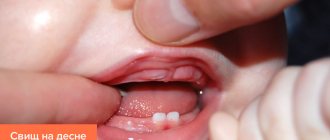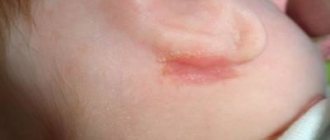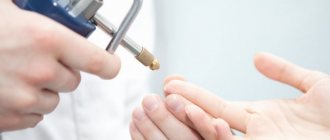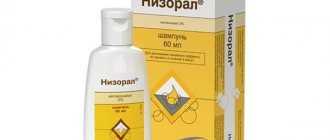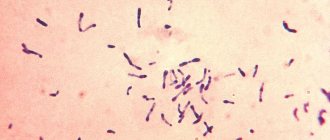The pertussis-diphtheria-tetanus vaccine is designed to protect the child's body from the penetration of dangerous viruses. Complex vaccination quite often provokes side effects.
In the post-vaccination period, fever, general malaise and a number of other unpleasant changes are possible. Often a lump appears at the injection site after DTP. It is worth figuring out what provokes its formation and how to help the baby.
The appearance of a lump: normal or not?
After vaccination has been carried out, the body's response is noted. Such changes are considered normal and do not cause concern. Often in children after DTP vaccination, a lump appears at the injection site. Its diameter should not exceed eight centimeters.
A large lump (more than eight centimeters) is not considered normal. As a rule, hyperthermia and other side effects are also noted. Such clinical manifestations are a reason to consult a doctor.
Lump from DPT vaccination
If over the course of a week the bump from the DTP vaccination has not become smaller, then pharmacological agents are used:
- The affected area is treated with the active substances Troxevasin or Troxerutin (1 time per day). The ointment will help reduce swelling and eliminate unpleasant itching. The active ingredients will accelerate the absorption of the drug into the blood;
- The active components of Aescusan will help speed up blood flow at the injection site and the seal will disappear faster. Apply once a day, before bed after bathing;
- For scabies, the use of active substances Fenistil is indicated. But it is forbidden to apply it to the injection site, solely on the halo. The product eliminates unpleasant symptoms, and after a few days the child will no longer be bothered by the leg;
- The homeopathic remedy Traumeel-S has proven itself quite well. But using it is not always rational, so the main thing is to consult a doctor;
- You can also apply Gepatrombin ointment to the bump. It will relieve swelling and will not cause allergic rashes, since the active substances of the drug are allowed to be used from an early age.
Rubbing, rubbing, or massaging the sore area is strictly prohibited. The less parents influence the lump, the faster it will resolve and go away on its own.
To avoid negative neoplasms, it is better to give the child antihistamine complexes: L-Cet, Fenistil, before administering an immunobiological drug. They will prevent swelling and inflammatory processes.
Reasons for appearance
The main reason for the formation of a lump is infiltration. The vaccine takes time to dissolve and therefore a swelling is noted at the injection site.
In addition, such changes are observed under the influence of the following factors:
- Injecting whey not into muscle tissue, but into adipose tissue. The drug accumulates under the skin and dissolves slowly. The compaction does not last long enough.
- Incorrect vaccination with damage to the skin and fat layer. Injury to tissue that is not yet properly formed leads to swelling.
- Reactions of lymphocytes to the administered drug.
- Failure to comply with sanitary standards during vaccination.
- Penetration of infection into the resulting wound.
The appearance of a red seal
Redness of the injection site and the appearance of a lump are considered normal. A red bump on a stalk can reach up to 80 millimeters in diameter and be accompanied by pain.
Sometimes the pain intensifies while walking. The baby tries to move the affected limb less.
The injection site becomes hot and red.
Such changes are caused by abundant blood flow and the onset of the inflammatory process. It will go away within ten days and does not require therapy.
If the medication gets into adipose tissue, a red bump may also appear.
If your baby develops a large lump, it is recommended to consult a pediatrician. He will prescribe treatment aimed at eliminating these symptoms. You should not self-medicate.
DPT lump does not resolve
If pharmacological remedies do not bring results and the DPT lump does not resolve, then the mother can try effective remedies:
- A solution of sodium bicarbonate is applied to the cone. It is diluted in a ratio of 1:250 ml. Cotton compresses are applied twice a day;
- Applying steamed cabbage leaf. The sheet is treated with boiling water, cuts are made, and applied to the wound. You can keep cabbage for up to 5 hours. The leaf treated with boiling water is distinguished by its antiseptic properties and helps eliminate any signs of inflammation. It is also important to make small cuts so that the leaf lets out liquid and becomes soft;
- Use of honey and aloe. Early in the morning, the lump is treated with juice, and honey is applied as a compress before bed. The plant stands out for its characteristics of resorption of fluid accumulations in tissues. However, in order for all the active substances to start working, it is recommended to keep the stem for several hours in a cold place. It is best to use the side shelf of the refrigerator compartment for this. Next, a gel-like liquid is squeezed out of the plant; it is best to use a fine grater, juicer or other available household devices. Previously, the plant was simply crushed and the juice was filtered through a porous cloth. Such a compress will work to eliminate the bump for several hours;
- An effective way to remove the bump is to apply raw potatoes - a large fruit is peeled and cut into several parts. The main thing is to fix it correctly so that it is in contact with the site of the lump for several hours. What are the beneficial properties of potato starch? It quickly removes excess fluid from the body, thereby reducing inflammation. Starch will enter the wound, even if the potato is cut into large pieces. But, to achieve a better result, it is recommended to grate it. The pulp is placed in a porous bag and applied to the inflamed area;
- Clay with a white tint - applied to the affected area during daytime sleep, then the residue is cleaned off with a cotton pad.
Popular Is the immune system better protected with Pentaxim or DTP?
Before applying any of these products to a wound, make sure that your baby does not have any negative reaction, including a rash or sneezing.
What measures to take
You can remove a lump in various ways. Ointments, a number of additional medications and traditional medicine methods will help. The main thing is not to use these products without prior approval from your pediatrician. Incorrectly administered therapy can aggravate the situation.
Ointments and creams
You can anoint the affected area with the following:
- Troxerutin or Troxevasin. You need to use the ointment three times a day. With its help, swelling is eliminated and pain is relieved. The active components of the medication help accelerate the resorption process.
- Aescusanus. Stimulates blood circulation in affected tissues. They are lubricated once during the day, before going to bed.
- Fenistil. Used in case of itching and discomfort. It is not the vaccination site itself that is treated, but the area around it.
- Heparin ointment. Helps eliminate swelling and swelling. No allergic reaction is observed with its use. The medication is safe for children of all ages.
- Vitaon. The cream has a similar effect to Heparin ointment.
Therapeutic compresses
Applying a warm compress to the affected area is not recommended. Moreover, you should not rub the injection site. Such actions will not lead to improvement of the condition. On the contrary, the size of the tubercle will increase and the development of an abscess is possible.
Additional medications
In addition to local medications, pediatricians recommend the use of agents that have an antiseptic effect. Thanks to their use, inflammation, redness is eliminated and the lump resolves.
When allergies develop, they resort to prescribing antihistamines. Zodak and Travelil are effective in this case.
ethnoscience
Positive changes are noted in the case of the use of the following folk remedies:
- Cabbage leaf. You need to cut it in several places and make sure that the juice begins to stand out. After this, the product should be applied to the tubercle, fixed and left overnight. Honey will help enhance the effect. It lubricates the surface of the sheet.
- Yoda. Promotes the resorption of the cone. You need to draw a mesh on the affected area and leave it until it is completely absorbed. The procedure is performed until the condition returns to normal.
- Pickles. You need to cut the salted zucchini or cucumber into rings. Take a piece, apply it to the seal and fix it in this position overnight. By morning the lump should disappear. It is strongly not recommended to cover the vegetable with film. A greenhouse effect is created, which is dangerous in the presence of inflammation.
- Mixtures of honey and flour. These components are taken in equal proportions and formed into a cake. Honey is heated in advance to make kneading the dough easier. The cake should be secured to the affected tissues and left overnight. You can perform such procedures three times.
- Cottage cheese. It is heated in a water bath and wrapped in double folded natural fabric. The product is applied to the cone until it cools completely.
What medications are prohibited after vaccination?
There is a ban on certain medications and vitamins that a baby should not take after any vaccination:
- Vitamin D is canceled 6 days after vaccination, as it can lead to the development of an allergic reaction. You can replace the vitamin with calcium gluconate in tablets;
- Suprastin - the drug dries out the airways, which leads to easy penetration of microbes. You can replace it with Fenistil or Zyrtec;
- Aspirin is prohibited - it is generally not recommended to give it to children due to its negative effect on the stomach.
For you: Vaccination schedule for adults: which viruses need to be protected against.
It is best to use local medications to combat a bump on the leg or other place.
Related Side Effects
In addition to the bump at the injection site, other changes may appear:
- temperature increased to 38 degrees Celsius (higher thermometer readings are an alarming symptom; hyperthermia requires medical attention);
- runny nose;
- cough;
- itching;
- sore throat;
- hoarseness;
- lack of appetite;
- weaknesses;
- apathy;
- diarrhea;
- stomach ache;
- gagging;
- nausea;
- conjunctivitis;
- irritability;
- colic;
- lameness;
- redness and pain at the injection site;
- rashes on the skin;
- seizures;
- headache;
- drowsiness.
Such symptoms are considered a normal immune response of the body and disappear within three days.
Possible complications from compaction
A dangerous complication against the background of the appearance of compaction is an abscess. The lump turns out to be filled with purulent exudate. A formation appears from the infiltrate, infected as a result of violation of the rules of care for the injection site.
Such changes are observed when pathogenic microorganisms penetrate. If you suspect an abscess, you should seek help from a medical facility. Traditional methods are powerless.
Among the signs of the onset of the pathological process are the following:
- In the center of the infiltrate, the appearance of purulent softening of the epithelial tissue is noted. The affected area expands around the periphery.
- The skin over the surface of the abscess is thin and dry, due to which it breaks through and the pus comes out.
- The skin in the affected area is hyperemic, hot and swollen.
- Hyperthermia (thermometer readings exceed 39 degrees Celsius);
- A throbbing pain syndrome in the area of the lump, due to which the baby begins to sleep and eat poorly and cries continuously.
An abscess is a dangerous phenomenon that occurs as a result of the appearance of a tubercle on the skin after DTP . There is a risk of its rupture and release of pus into the subcutaneous tissue. Cellulitis forms. To avoid such consequences, the abscess is opened, the pus is removed and the affected area is washed using antiseptics.
This procedure is performed in a medical facility. After this, the child is prescribed antibiotics to prevent relapse.




